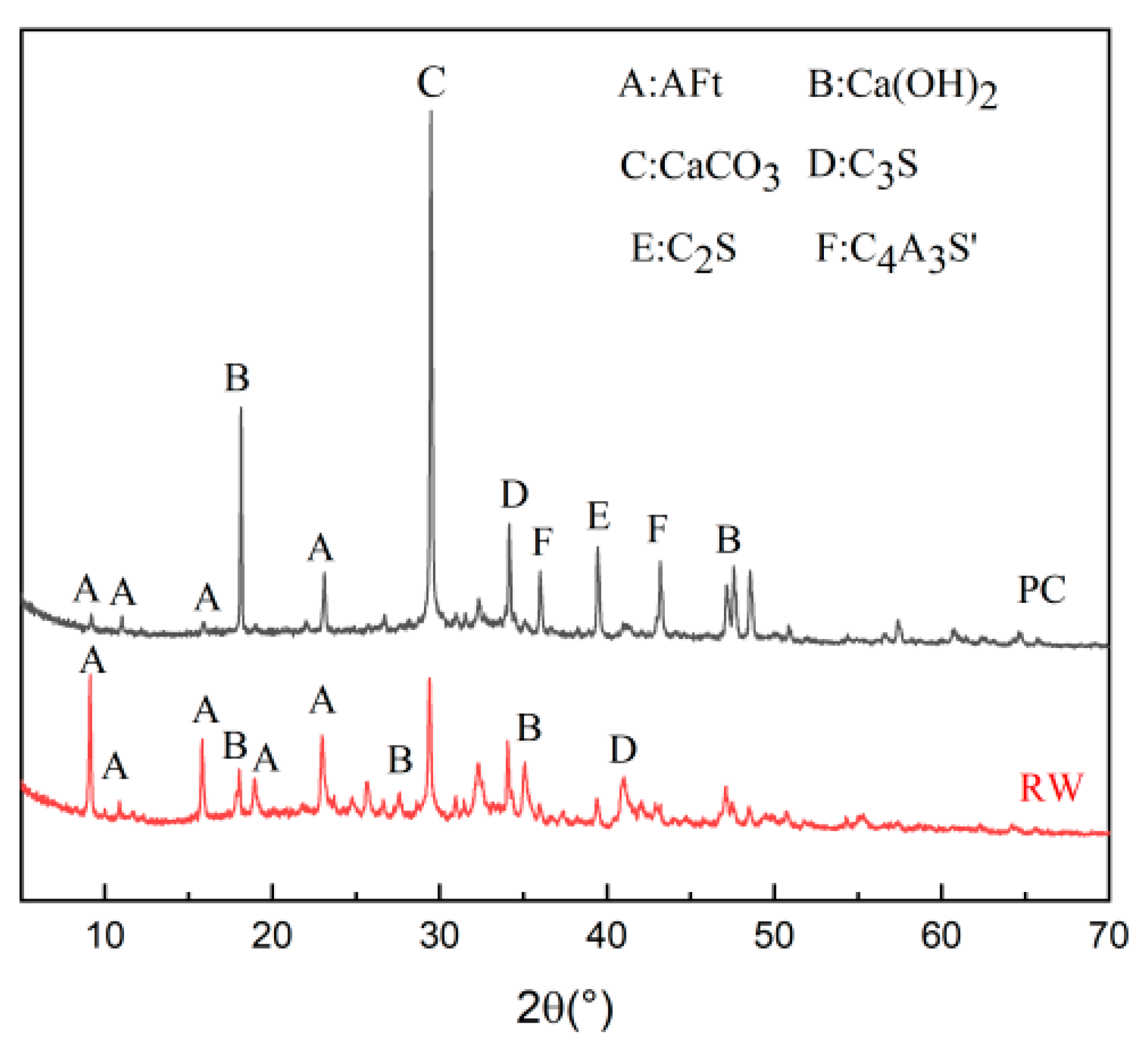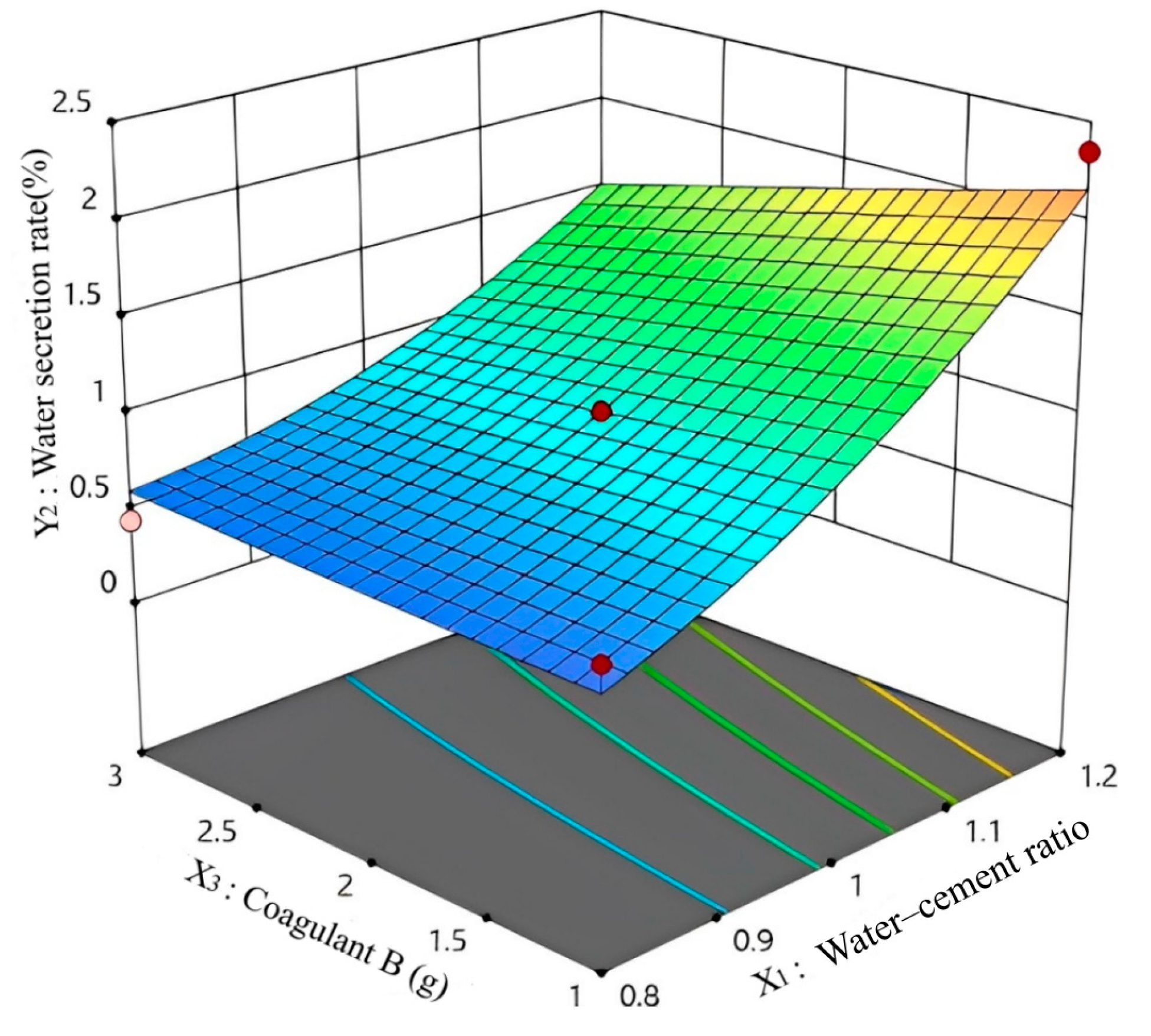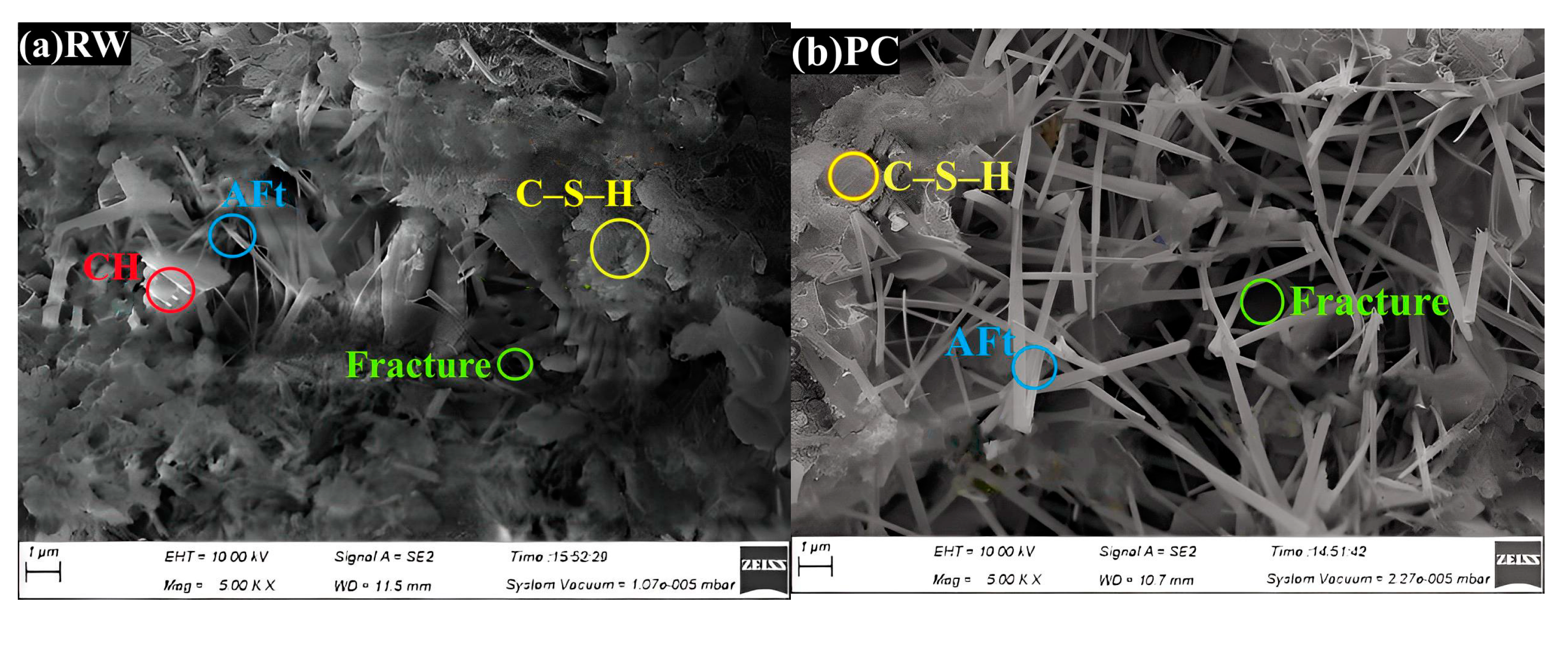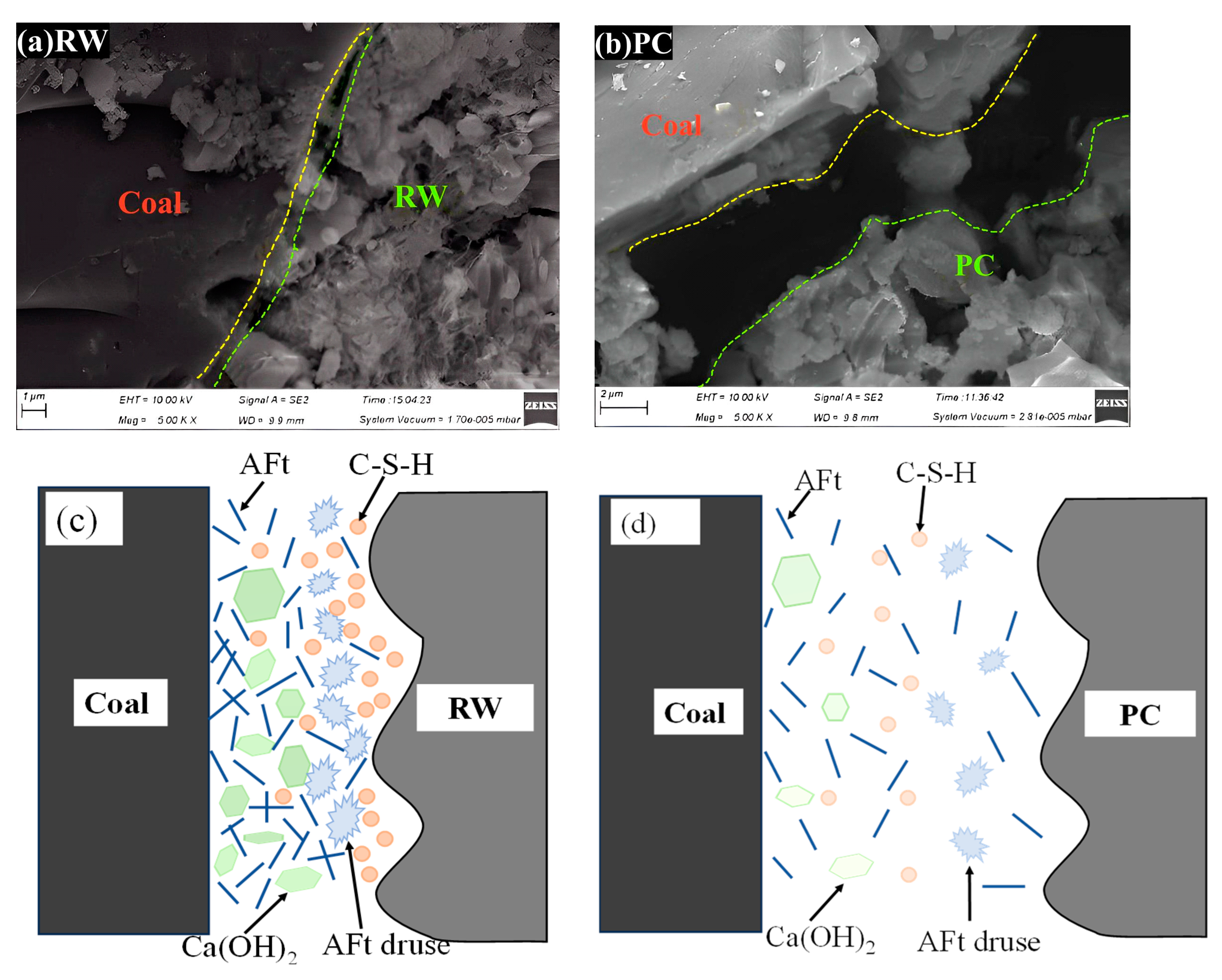Study on Performance Optimization of Water-Rich Grouting Materials Based on Response Surface Methodology
Abstract
:1. Introduction
2. Materials Preparation and Test Methods
2.1. Raw Materials
2.2. Test Program
2.3. Test Methods
- (1)
- Test for setting time
- (2)
- Test for water secretion rate
- (3)
- Test for compressive strength
3. Response Surface Methodology Analysis
3.1. Selection of Coagulants
3.2. Experimental Response Surface Study
3.2.1. Experimental Design and Results
3.2.2. Analysis of Regression Model
3.2.3. Analysis of Response Surface
- (1)
- Effect of interaction factors on setting time
- (2)
- Effect of interacting factors on water secretion rate
- (3)
- Effect of interaction factors on compressive strength
4. Microscopic Interface Analysis of Slurry–Coal Solids
4.1. Microscopic Morphology Analysis of Grouting Materials
4.2. Microscopic Morphology Analysis of Slurry–Coal Solids
5. Conclusions
Author Contributions
Funding
Data Availability Statement
Conflicts of Interest
References
- Asif, M.; Wang, L.; Wang, R.; Wang, H.; Hazlett, R. Mechanisms in CO2-enhanced coalbed methane recovery process. Adv. Geo-Energy Res. 2022, 6, 531–534. [Google Scholar] [CrossRef]
- Andrews-Speed, P.; Xu, X.; Jie, D.; Chen, S.; Zia, M. Deficiencies in China’s innovation systems for coal-bed methane development: Comparison with the USA. J. Sci. Technol. Policy Manag. 2023, 14, 511–528. [Google Scholar] [CrossRef]
- Wu, A.; Ruan, Z.; Raimund, B.; Yin, S.; Wang, J.; Wang, Y. Optimization of flocculation and settling parameters of tailings slurry by response surface methodology ology. Miner. Eng. 2020, 156, 106488. [Google Scholar] [CrossRef]
- Gao, Q.; Yang, X.; Wen, Z.; Chen, D.; He, J. Optimization of proportioning of mixed aggregate filling slurry based on BBD response surface methodology. J. Hunan Univ. Nat. Sci. 2019, 46, 6. [Google Scholar]
- Wang, H.; Fan, C.; Li, J.; Wu, Y.; Xing, S.; Wang, W. A Field Study of Coal Fire Areas Re-Burning Behavior Assessment and Related Carbon Emissions. Fire 2022, 5, 186. [Google Scholar] [CrossRef]
- Bosikov, I.; Martyushev, N.; Klyuev, R.; Savchenko, I.; Kukartsev, V.; Tynchenko, Y. Modeling and complex analysis of the topology parameters of ventilation networks when ensuring fire safety while developing coal and gas deposits. Fire 2023, 6, 95. [Google Scholar] [CrossRef]
- Silva, D.; Nuzzo, I.; Nigro, E.; Occhiuzzi, A. Intumescent coatings for fire resistance of steel structures: Current approaches for qualification and design. Coatings 2022, 12, 696. [Google Scholar] [CrossRef]
- Zhang, J.; Li, G.; Meng, Z.; Zhang, Y.; Liu, L.; Li, D.; Xu, Y. Key technology of surface extraction for coalbed methane wells crossing goaf. J. China Coal Soc. 2020, 45, 2552–2561. [Google Scholar]
- Joshi, D.; Prajapati, P.; Sharma, P.; Sharma, A. Past, present and future of coal bed methane (CBM): A review with special focus on the Indian scenario. Int. J. Coal Prep. Util. 2023, 43, 377–402. [Google Scholar] [CrossRef]
- Zhu, C.; Zhang, J.; Li, M.; He, Z.; Wang, Y.; Lan, Y. Effect mechanism of strata breakage evolution on stope deformation in extra-thick coal seams. Alex. Eng. J. 2022, 61, 6. [Google Scholar] [CrossRef]
- Kędzior, S.; Teper, L. Coal Properties and Coalbed Methane Potential in the Southern Part of the Upper Silesian Coal Basin, Poland. Energies 2023, 16, 3219. [Google Scholar] [CrossRef]
- Wang, H.; Li, B.; Wang, Y.; Li, S.; Zhang, G.; Yang, D. Key technology and bottlenecks of multi-energy complementary DC microgrid for residual coalbed methane in abandoned mine. J. China Coal Soc. 2023, 48, 1798–1813. [Google Scholar]
- Jia, Q.; Liu, D.; Cai, Y. Research progress on wells interference in coalbed methane mining. J. China Coal Soc. 2020, 45, 882–893. [Google Scholar]
- Wang, Z.; Zhou, Y.; Sun, Y.; Wang, Y. Novel gas extraction borehole grouting sealing method and sealing mechanism. J. China Coal Soc. 2015, 40, 588–595. [Google Scholar]
- Zhang, J.; Liu, Y.; Ren, P. A fully multifield coupling model of gas extraction and air leakage for in-seam borehole. Energy Rep. 2021, 7, 1293–1305. [Google Scholar] [CrossRef]
- Wang, H.; Wang, E.; Li, Z.; Wang, X.; Zhang, Q.; Li, B. Ali Muhammad. Study on sealing effect of pre-drainage gas borehole in coal seam based on air-gas mixed flow coupling model. Process Saf. Environ. Prot. 2020, 136, 15–27. [Google Scholar] [CrossRef]
- Si, L.; Shi, W.; Wei, J.; Liui, Y.; Yao, B. Self-healing characteristics of fracture in sealing materials based on self-healing effect. J. China Coal Soc. 2023, 1–14. [Google Scholar] [CrossRef]
- Xia, T.; Zhou, F.; Liu, J.; Hu, S.; Liu, Y. A fully coupled coal deformation and compositional flow model for the control of the pre-mining coal seam gas extraction. Int. J. Rock Mech. Min. Sci. 2014, 72, 138–148. [Google Scholar] [CrossRef]
- Chen, X.; Zhou, T.; Zhou, J.; Ma, L.; Liu, Q.; Xu, X. Study on the flame retardant property of reactive halogen-free organic grouting reinforcement materials for coal mines. Min. Saf. Environ. Prot. 2023, 50, 40–45. [Google Scholar]
- Sun, W.; Guo, B.; Zhang, R. Effect of hydroxide properties of new material for sealing gas drainage boreholes. China Saf. Sci. J. 2016, 26, 98–102. [Google Scholar]
- Zhao, Y.; Sun, Y.; Wang, Z. Mixed volume of aluminous cement affected to grouting material performances of borehole sealing for gas drainage. Coal Sci. Technol. 2018, 46, 146–152. [Google Scholar]
- Liu, J.; Luo, Q.; Ji, X.; Wu, F.; Ma, M.; Zhang, C.; Wang, Q. Study on preparation and performance of an early strength grouting materials. J. Saf. Sci. Technol. 2018, 14, 95–99. [Google Scholar]
- Qian, Z.; Han, B. Experimental study on water absorption performance of super absorbent resin in sealing and grouting process of gas drainage borehole. Saf. Coal Mines 2020, 51, 32–36. [Google Scholar]
- Guan, X.; Li, X.; Zhang, H.; Yang, Z.; Li, H.; Di, H.; Zhang, L. Research and application of inorganic composite grouting reinforcement materials in deep weak rock. Coal Sci. Technol. 2023, 51, 1–11. [Google Scholar]
- Liu, J.; Feng, H.; Zhang, Y.; Zheng, K. Performance Investigation of Geopolymer Grouting Material with Varied Mix Proportions. Sustainability 2022, 14, 13046. [Google Scholar] [CrossRef]
- Zhang, J.; Wang, X.; Jin, B.; Zhang, X.; Li, Z.; Guan, X. Effect of superplasticizers on hydration kinetics of ultrafine sulfoaluminate cement-based grouting material. Thermochim. Acta 2021, 703, 178988. [Google Scholar] [CrossRef]
- Ruan, W.; Zhang, Z.; Cai, M.; She, Y.; Liu, J.; Guo, W.; Ma, X.; Liao, J.; He, X. Comparative study of the effects of magnesium aluminum silicate and bentonite clay on the properties of magnesium phosphate cement-based grouting material. Constr. Build. Mater. 2023, 401, 132852. [Google Scholar] [CrossRef]
- Choudhury, S.; Jena, T. Influence of surfactant on foam generation and stabilization in cement slurry. Mater. Today Proc. 2023. [Google Scholar] [CrossRef]
- Mahmood, W.; Mohammed, A.; Asteris, P.; Kurda, R.; Armaghani, D. Modeling flexural and compressive strengths behaviour of cement-grouted sands modified with water reducer polymer. Appl. Sci. 2022, 12, 1016. [Google Scholar] [CrossRef]
- Pereira, L.; Milan, T.; Tapia-Blácido, D. Using Response Surface Methodology (RSM) to optimize 2G bioethanol production: A review. Biomass Bioenergy 2021, 151, 106166. [Google Scholar] [CrossRef]
- Liu, Y.; Zhao, C.; Li, G.; Zhao, X.; Li, Z.; Zhang, X.; Li, Y.; Guo, J.; Guo, D. Optimized decision method of coordinated development mode of coal and coalbed methane in Jincheng mining area. J. China Coal Soc. 2020, 45, 2575–2589. [Google Scholar]
- Liang, W.; Zhang, B.; He, W.; Yao, H. Experimental research on supercritical CO2 enhanced coalbed methane recovery in different rank coals. J. China Coal Soc. 2020, 45, 197–203. [Google Scholar]
- Zhang, J.; Liu, L.; Li, Q.; Peng, W.; Zhang, F.; Cao, J.; Wang, H. Development of cement-based self-stress composite grouting material for reinforcing rock mass and engineering application. Constr. Build. Mater. 2019, 201, 314–327. [Google Scholar] [CrossRef]
- Zhang, Y.; Wang, Y.; Wu, Z.; Lu, Y.; Kang, A.; Xiao, P. Optimal design of geopolymer grouting material for semi-flexible pavement based on response surface methodology. Constr. Build. Mater. 2021, 306, 124779. [Google Scholar] [CrossRef]
- Petruniak, M.; Rubel, V.; Chevhanova, V.; Kulakova, S. Application of grout slurries with the defecate addition for effective well cementing. Min. Miner. Depos. 2021, 15, 59–65. [Google Scholar] [CrossRef]
- Liu, W.; Sun, Y.; Meng, X.; Qin, Y. Experimental analysis of Nano-SiO2 modified waterborne epoxy resin on the properties and microstructure of cement-based grouting materials. Energy 2023, 268, 126669. [Google Scholar] [CrossRef]
- Liu, J.; Li, X.; He, T. Application status and prospect of backfill mining in Chinese coal mines. J. China Coal Soc. 2020, 45, 141–150. [Google Scholar]
- Behnia, B.; AaliAnvari, A.; Nazari, M. A study to examine the effect of grouting superfine cement slurry containing nano-silica additives by a simulator cylinder in environments with many joints and gaps. Arab. J. Geosci. 2021, 14, 1–15. [Google Scholar] [CrossRef]
- Wei, Z.; Yang, K.; He, X.; Zhang, J.; Hu, G. Experimental study on the optimization of coal-based solid waste filling slurry ratio based on the response surface methodology. Materials 2022, 15, 5318. [Google Scholar] [CrossRef] [PubMed]
- Basu, P.; Thomas, B.S.; Gupta, R.C.; Vinay, A. Properties of sustainable self-compacting concrete incorporating discarded sandstone slurry. J. Clean. Prod. 2021, 281, 125313. [Google Scholar] [CrossRef]
Disclaimer/Publisher’s Note: The statements, opinions, and data contained in all publications are solely those of the individual author(s) and contributor(s), and not of MDPI and/or the editor(s). MDPI and/or the editor(s) disclaim responsibility for any injury to people or property resulting from any ideas, methods, instructions, or products referred to in the content. |










| Coagulants Kinds | Dosage/g | ||
|---|---|---|---|
| Coagulant A | 2 | 4 | 6 |
| Coagulant B | 1 | 2 | 3 |
| Coagulant C | 2 | 4 | 6 |
| Factors | Variables | Level | ||
|---|---|---|---|---|
| −1 | 0 | 1 | ||
| Water–cement ratio | X1 | 0.8 | 1.0 | 1.2 |
| Coagulant A | X2 | 2 | 4 | 6 |
| Coagulant B | X3 | 1 | 2 | 3 |
| Suspending agent | X4 | 5 | 10 | 15 |
| Group | Level | Results | |||||
|---|---|---|---|---|---|---|---|
| X1 | X2 | X3 | X4 | Y1/min | Y2/% | Y3/MPa | |
| 1 | 0 | 0 | 0 | 0 | 360 | 0.98 | 6.52 |
| 2 | 0 | 1 | 1 | 0 | 408 | 1.03 | 7.95 |
| 3 | 0 | 0 | 0 | 0 | 304 | 1.02 | 7.74 |
| 4 | 1 | 0 | 0 | −1 | 240 | 0.61 | 11.41 |
| 5 | 0 | 1 | 0 | 1 | 300 | 1.06 | 8.56 |
| 6 | 1 | 1 | 0 | 0 | 276 | 0.89 | 7.3 |
| 7 | −1 | 0 | 0 | −1 | 516 | 2.35 | 5.45 |
| 8 | −1 | 1 | 0 | 0 | 400 | 1.08 | 6.52 |
| 9 | 0 | 0 | −1 | −1 | 304 | 1.02 | 7.74 |
| 10 | 0 | −1 | 1 | 0 | 272 | 0.93 | 8.37 |
| 11 | 1 | 0 | −1 | 0 | 304 | 1.02 | 7.74 |
| 12 | 0 | −1 | 0 | −1 | 492 | 1.96 | 5.1 |
| 13 | 0 | 0 | 1 | 1 | 296 | 0.96 | 8.55 |
| 14 | 0 | 0 | 1 | −1 | 480 | 1.77 | 5.91 |
| 15 | 0 | 0 | 0 | 0 | 240 | 0.61 | 11.41 |
| 16 | 1 | −1 | 0 | 0 | 208 | 0.55 | 11.82 |
| 17 | 0 | 1 | −1 | 0 | 420 | 1.13 | 7.92 |
| 18 | −1 | 0 | 1 | 0 | 296 | 0.95 | 6.11 |
| 19 | 1 | 0 | 1 | 0 | 516 | 2.35 | 5.45 |
| 20 | 1 | 0 | 0 | 1 | 400 | 1.08 | 6.52 |
| 21 | 0 | 0 | 0 | 0 | 276 | 0.89 | 7.3 |
| 22 | 0 | 0 | −1 | 1 | 280 | 0.99 | 7.25 |
| 23 | 0 | 0 | 0 | 0 | 304 | 1.02 | 7.74 |
| 24 | 0 | 1 | 0 | −1 | 500 | 1.83 | 4.47 |
| 25 | −1 | 0 | 0 | 1 | 404 | 1.07 | 8.96 |
| 26 | −1 | 0 | −1 | 0 | 176 | 0.44 | 11.15 |
| 27 | 0 | −1 | 0 | 1 | 472 | 1.42 | 4.89 |
| 28 | −1 | −1 | 0 | 0 | 484 | 1.65 | 5.1 |
| 29 | 0 | −1 | −1 | 0 | 304 | 1.02 | 7.74 |
| Data Sources | Degrees of Freedom | Setting Time | Water Secretion Rate | Compressive Strength | |||
|---|---|---|---|---|---|---|---|
| F | P | F | P | F | P | ||
| Model | 14 | 30.8 | <0.0001 | 37.27 | <0.0001 | 268.78 | <0.0001 |
| X1 | 1 | 335.88 | <0.0001 | 458.67 | <0.0001 | 3353.07 | <0.0001 |
| X2 | 1 | 13.64 | 0.0006 | 0.2022 | 0.6598 | 292 | <0.0001 |
| X3 | 1 | 0.8743 | <0.0001 | 5.18 | 0.0003 | 34.18 | <0.0001 |
| X4 | 1 | 66.94 | 0.2875 | 23.64 | 0.0390 | 0.0119 | 0.9146 |
| X1X2 | 1 | 7.95 | 0.0155 | 0.0379 | 0.8484 | 15.72 | 0.0019 |
| X1X3 | 1 | 5.44 | 0.0378 | 11.28 | 0.0047 | 13.31 | 0.0033 |
| X1X4 | 1 | 0.0066 | 0.9366 | 6.05 | 0.0324 | 1.05 | 0.3254 |
| X2X3 | 1 | 6.38 | 0.0281 | 1.47 | 0.2856 | 5.26 | 0.0407 |
| X2X4 | 1 | 3.95 | 0.0755 | 0.0976 | 0.7593 | 1.12 | 0.3102 |
| X3X4 | 1 | 0.0262 | 0.8737 | 8.93 | 0.0245 | 0.0029 | 0.9577 |
| X12 | 1 | 8.44 | 0.0115 | 19.55 | 0.0006 | 65.68 | <0.0001 |
| X22 | 1 | 3.32 | 0.0899 | 0.0517 | 0.8235 | 2.32 | 0.1496 |
| X32 | 1 | 6.71 | 0.0448 | 0.0385 | 0.8472 | 1.35 | 0.2641 |
| X42 | 1 | 1.33 | 0.2688 | 0.0309 | 0.8631 | 0.4195 | 0.5277 |
| Lack of Fit | 10 | 1 | 0.5464 | 9.77 | 0.0732 | 11.04 | 0.0865 |
| R2 = 0.9777 | R2 = 0.9739 | R2 = 0.9963 | |||||
| Radj2 = 0.9533 | Radj2 = 0.9477 | Radj2 = 0.9926 | |||||
| CV% = 6.05 | CV% = 9.43 | CV% = 2.35 | |||||
Disclaimer/Publisher’s Note: The statements, opinions and data contained in all publications are solely those of the individual author(s) and contributor(s) and not of MDPI and/or the editor(s). MDPI and/or the editor(s) disclaim responsibility for any injury to people or property resulting from any ideas, methods, instructions or products referred to in the content. |
© 2023 by the authors. Licensee MDPI, Basel, Switzerland. This article is an open access article distributed under the terms and conditions of the Creative Commons Attribution (CC BY) license (https://creativecommons.org/licenses/by/4.0/).
Share and Cite
Li, X.; Han, G.; Wang, Y.; Xu, J.; Du, J.; Yang, B.; Zhang, M.; Li, T.; Li, B. Study on Performance Optimization of Water-Rich Grouting Materials Based on Response Surface Methodology. Processes 2023, 11, 2789. https://doi.org/10.3390/pr11092789
Li X, Han G, Wang Y, Xu J, Du J, Yang B, Zhang M, Li T, Li B. Study on Performance Optimization of Water-Rich Grouting Materials Based on Response Surface Methodology. Processes. 2023; 11(9):2789. https://doi.org/10.3390/pr11092789
Chicago/Turabian StyleLi, Xiaoping, Guoping Han, Yong Wang, Jie Xu, Jie Du, Bo Yang, Min Zhang, Tao Li, and Bo Li. 2023. "Study on Performance Optimization of Water-Rich Grouting Materials Based on Response Surface Methodology" Processes 11, no. 9: 2789. https://doi.org/10.3390/pr11092789




